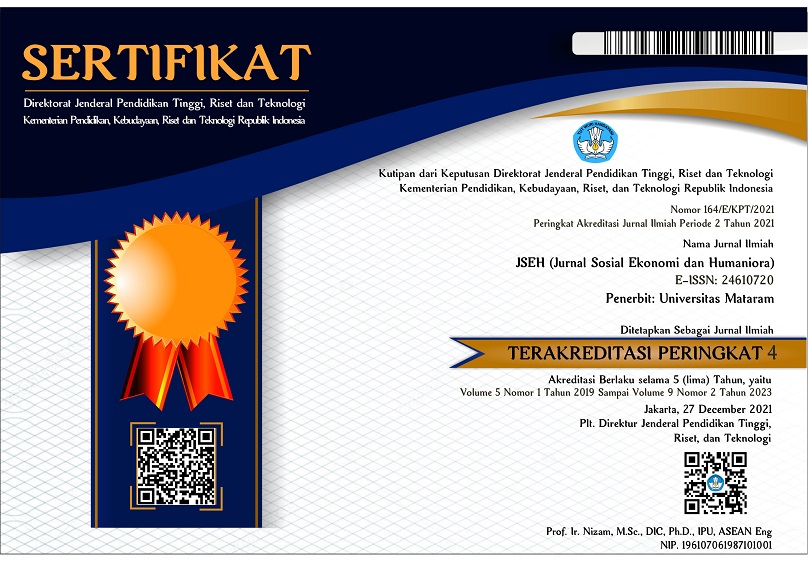Readiness of Jati Larangan Tourism Object and Sengon Park as a Tourist Attraction Effort Recovery Post-Pandemic Economic Activity
DOI:
https://doi.org/10.29303/jseh.v8i3.140Keywords:
Economic Recovery, Tourist Village, Community Based TourismAbstract
Jati Larangan and Sengon Park are an example of community innovation in Iroyudan, Guwosari Village, Pajangan District, Bantul Regency, Special Region of Yogyakarta, in a joint effort to create a more prosperous society, through the development of tourism activities. This study uses descriptive research with a qualitative approach, namely research that aims to make a systematic, factual and accurate description of a social or natural phenomenon, by collecting data, then analyzing it with elaborative explanations. The characteristics of tourists in Jati Larangan and Sengon Park are relatively supportive of efforts to restore economic in the tourism activity during the current pandemic, where people's activities and mobility are limited to certain areas around them. The location of Jati Larangan and Sengon Park, which are in a large open area, has resulted in no clash between site conditions and regulations in the government's effort to reduce the rate of transmission of the covid-19 pandemic.
References
Amelia, V., & Prasetyo, D. (2020). Cerme Cave Management as a Sustainable Tourism Attraction. JOURNAL OF TOURISM DESTINATIONS, 8 (2), 311. https://doi.org/10.24843/JDEPAR.2020.v08.i02.p20
Elsahawi, M. (2016). Community participation in the development of tourist villages and their impact on improving the community's economy. Literature Studies, 3 (1).
Fachri, S. (2018). Religious tourism objects: Socio-economic potential and impact on local communities (case study at the Tomb of Sheikh Mansyur Cikadueun, Pandeglang). Syiar Iqtishadi: Journal of Islamic Economics, Finance and Banking, 2 (1), 25–44.
Fauzan, A., Aziz, LA, & Fujiama, ES (2022). “Tomb Pilgrimage” in Lombok: The Intersection of Prayer and Tourism Activities (Case Study at the Tomb of TGH Mutawalli, East Lombok). Scientific Journal of Mandala Education, 8 (3).
Gunawan, AS, Hamid, D., & Endang, MGW (2016). Analysis of Tourism Development on Socio-Economic Society. Brawijawa University Malang, 32 .
http://bappeda.jogjaprov.go.id/. (2022). Tourism Village and Pokdarwis. http://bappeda.jogjaprov.go.id/dataku/data_dasar/index/211pariwisata
Jogiyanto Hartono, M. (2018). Data Collection Methods and Analysis Techniques . Andi Publisher.
kemenparekraf.go.id. (2022). 1.37 Million Tourists Come to Bantul Throughout 2021. https://pedulicovid19.kemenparekraf.go.id/137-juta-wisatawan-dalam-ke-bantul-sepanjang-tahun-2021/
Martina, S. (2014). The impact of the management of the white crater nature park on the social and economic life of the community. Journal of Tourism, 1 (2), 81–88.
Nandi, N. (2016). Tourism and human resource development. Journal of Geography of Gea, 8 (1), 33–42.
Nurma, & Rachmanto. (2020). Jati Larangan Park, a New Tourist Destination in Bantul Regency . https://bantulkab.go.id/berita/detail/4306/taman-jati-larangan---destinasi-wisata-baru-di-kabupaten-bantul.html
Pratama, AH, Nughroho, S., & Suryasih, IA (2022). The Role of Local Communities in Realizing Citengah Village as a Tourism Village in Sumedang Regency. Journal of Education and Counseling (JPDK), 4 (5), 4291–4302.
Prihantara, F., Irawan, P., & Sari, YK (2018). The impact of religious tourism in the Sunan Kudus Mosque area on the economy, environment, and socio-culture . UGM PRESS.
Purwaningrum, H., & Ahmad, H. (2021). Evaluation of Jati Larangan and Sengon Park Tourism Management through Indicator 5A in Iroyudan Hamlet. Tourism: Scientific Journal , 15 (2).
Rahman, Y., Asbi, AM, & Putri, HT (2020). Analysis of changes in people's economic behavior as a result of community-based tourism development (a case study of driving tourism in the coastal tourism village of Pagar Jaya, Pesawaran Regency). National Journal of Tourism, 12 (1), 38–50.
Setiawan, RI (2016). Human resource development in tourism: Perspectives on developing regional tourism potential. Journal of Applied Management Research (PENATARAN), 1 (1), 23–35.
Silitonga, SSM, & Anom, P. (2016). Kota Tua Barus as a historical tourism destination in Central Tapanuli Regency. Journal of Tourism Destinations. ISSN , 2338–8811.
Sutiyono, S., & Prasetyo, D. (2020). The Strategy of the Character Padepokan in Strengthening Critical Thinking Characters in Young Citizens of the 21st Century. Journal of Character Education , 10 (1), 90–102.
Thalia, Z., & Sugiyarti, R. (2011). Development of Pilgrimage-Based Cultural Tourism as Special Interest Tourism in Karanganyar Regency.
Vanlith, CR (2019). The Level of Visitor's Approval of the Type of Tourism Motivation and Its Influence on the Intention of Repeat Visits in Religious Tourism Objects (Case Study of Maria Kerep Cave Ambarawa) . Gadjah Mada University.
Wiwin, IW (2017). Special Interest Tourism as an Alternative for Tourism Development in Bangli Regency. Cultural Tourism: Scientific Journal of Religion and Culture, 2 (2), 42–52.
Yakup, AP (2019). The Influence of the Tourism Sector on Economic Growth in Indonesia. Airlangga University.
Downloads
Published
How to Cite
Issue
Section
License
Copyright (c) 2022 Moch. Nur Syamsu, Rakhmat Ashartono, Hesti Purwaningrum, Halim Ahmad

This work is licensed under a Creative Commons Attribution-NonCommercial 4.0 International License.








